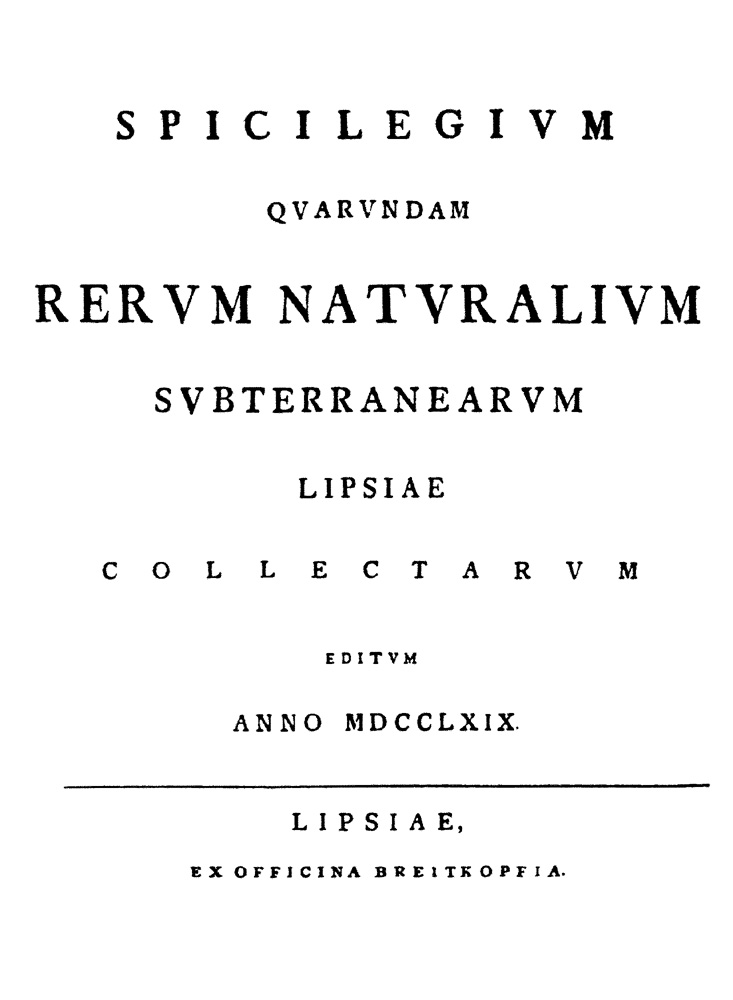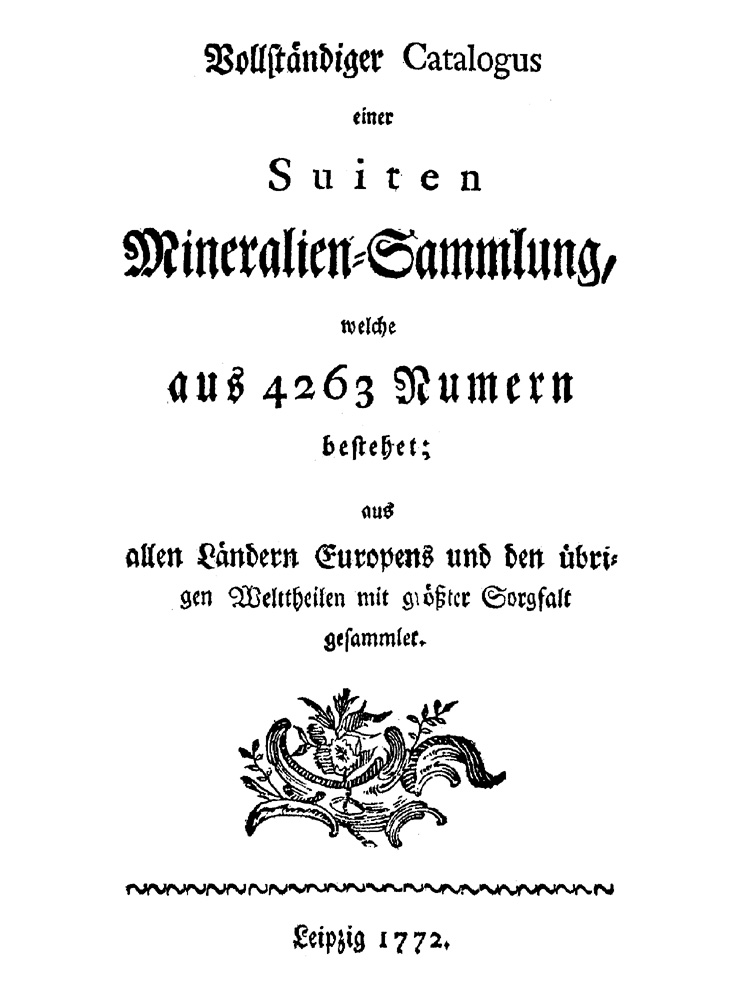STIEGLITZ, Christianus Ludovicus.
(1724 – 1772)
Stieglitz was educated at the University of Leipzig, obtaining an advanced degree in jurisprudence. He held several high positions in the city government of Leipzig. In 1754 he married Christiane Richter, daughter of Johann Christoph Richter, the founder of the "Museum Richterianum" in Leipzig, described and illustrated by Hebenstreit in 1754. In 1765 Christian and his two younger brothers were appointed "Nobles of the Empire" in Bohemia. They had a son of the same name [1756-1836], who became a prominent art historian and architectural archeologist.
Biographical references: Wilson, History of Mineral Collecting, 1994: 96-8.

1. German & Latin, 1769.
Spicilegivm | Qvarvndam | Rervm Natvralivm | Svbterranearvm | Lipsiae | Collectarvm | Editvm | Anno MDCCLXIX | [rule] | Lipsiae, | Ex Officina Breitkopfia.
4°: [A]-C4; 12l.; [1]-24 p., 21 engraved, hand-colored plates. Page size: 277 x 250 mm.
Contents: [1-2], Title page, verso blank.; [3], Dedication to the "Principi Electori Saxoniæ Friderico Avgvsto," signed "Christianus Ludovicus Stieglitz."; [4], Blank.; [5]-[6], "Lectoribvs Salvtem" [Begins with a colored headpiece showing dendrites on sandstone].; [7]-16, "Descriptiones Figvrarvm" [=Latin descriptions of figures on the plates].; 17-24, "Erklärung der Kupfer-Tafeln" [=German descriptions of figures on the plates].; [At end], 21 plates.
Plates: The 21 engraved, hand-colored plates are all unsigned. Each is numbered in Roman numeral preceeded by the word "Tab." Of the 65 specimens illustrated, each is labeled so that it may be matched to the text description.
Extremely rare. Although published anonymously, the introduction is signed by Stieglitz, who is likely to be the author of the text. It is the great beauty of the hand-colored plates that strike the reader, however. Each shows one or more examples of 65 mineral specimens selected for illustration from the author's large collection in realistic renderings. Particularly notable among the minerals pictured are wire silvers and calcites from the mines of Saxony, as well as the first illustration of native iron from Disco Island, Greenland. Freisleben (1828) records that the engravings and coloring were prepared by a miniaturist painter by the name of Morino. The text is occupied with descriptions of the specific specimens, which is written in both German and Latin. Unfortunately, this work is among the rariest of all hand-colored mineralogies, with only a very few copies known.
Stieglitz's collection must have been one of the better known during the eighteenth century. Cronstedt makes note of it, and Werner records in his article on collections, "Von den verschiednerley Mineraliensammlungen, aus denen ein vollständiges Mineralienkabinett bestehen soll" [See: Sammlungen zur Physik und Naturgeschichte: 1 (1778), 387-420], that "In the Stieglitz collection ... the Fossils were placed ... according to their respective countries, which were not however disposed in the best geographical Order ... It contained no specimens of the different Rocks; and the Fossils of each land, province or mining district, were arranged methodically ... according to the Earth's, Stones, Metals, &c." (Hailstone, 1792). Unfortunately, the only record of its contents exist in this splendid hand-colored mineralogy and the collection catalog listed below.
Facsimile reprint, 1992: Specimens | Of Some | Natural Things | From Underground | In A Leipzig | Collection | Edition Of | 1769 | [rule] | Leipzig, | From The Breitkopf Workshop. | [rule] | New Edition | 1992 | The Mineralogical Record | Tucson | (edition limited to 50 copies). 4°: [1]-24 p., 21 color plates.
[1-2], Title page in Latin, verso blank.; [3-4], Title page in English, verso blank.; [5], Dedication in Latin.; [6], Blank.; [7], Dedication in English.; [8], Blank.; 9-13, "Preface | To The | New Edition."; [14], Blank.; [15-16], "Lectoribvs | Salvtem."; [17], "To The Readers: | Greetings."; [18], Blank.; [19]-36, Facsimile of original text.; [37]-46, English translation of text.; [At end], 21 plate reproductions.
Facsimile reprint with added material. Published as a volume in the Mineralogical Record series of antiquarian reprints, this edition adds an English translation of the dedication and a new preface with historical information about this work. In addition, the text of the plate descriptions has been translated into English.
Bibliographical references: Freiesleben, Sächsische Mineralien-Verzeichnisse, 1828: no. 23. • Hailstone, J., A Plan of a Course of Lectures on Mineralogy. Cambridge, 1792: 39-40. • LKG: VI 44 & XIV 198. • Wilson, History of Mineral Collecting, 1994: 46, 96-98 & 225.

2. German, 1772 [Collection catalog].
Vollständiger Catalogus | einer | Suiten | Mineralien=Sammlung, | welche | aus 4263 Numern | bestehet; | aus | allen Ländern Europens und den übri- | gen Welttheilen mit größter Sorgfalt | gesammlet. | [ornament] | [ornate rule] | Leipzig 1772.
8°: [1]-301 p.
Extremely rare. Published anonymously but likely prepared by Stieglitz. Sale catalog of the author's fine mineral collection, which Werner records was sold to the Theresian College in Vienna (Hailstone, 1792). One could speculate that the author's colored mineralogy Spicilegivm Qvarvndam Rerum Natvralivm Svbterranearum Lipsiæ Collectarvm (Leipzig, 1769) was perhaps a prospectus for selling the collection to a Saxon Noble. However, when this failed to produce a buyer, the full collection catalog was published as the present title.
Bibliographical references: BL [972.e.14.(1.)]. • Freiesleben, Sächsische Mineralien-Verzeichnisse, 1828: no. 27. • Hailstone, J., A Plan of a Course of Lectures on Mineralogy. Cambridge, 1792: 39-40. • Wilson, History of Mineral Collecting, 1994: 225.
.